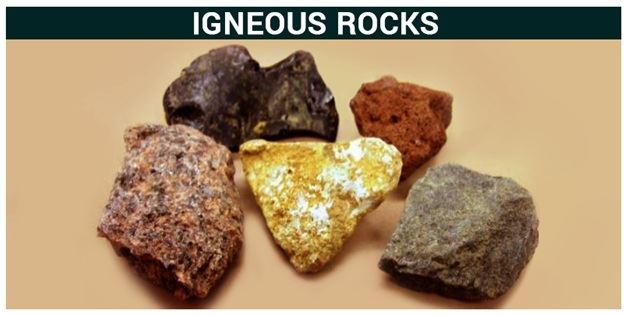Back to: GEOGRAPHY SS1
Welcome to class!
In today’s class, we will be talking about the rocks of the earth. Enjoy the class!
Rocks of the Earth
/rockcycle-58b9de235f9b58af5cba3148.jpg)
The earth crust consists of rocks. A rock is any mineral material of the earth. It may be a combination of different mineral elements such as silica which contains silicon and oxygen. All the rocks differ from one another in texture, structure, colour, permeability, mode of occurrence and degree of resistance to denudation.
Types of rocks
Rocks are classified into the following;
- Igneous rocks
- Sedimentary rocks and
- Metamorphic rocks.
Igneous rocks:

Characteristics of igneous rocks
- They are crystalline in structure ie they contain crystals.
- They do not occur in layers.
- They do not contain fossils.
- They are usually hard and impervious.
- They are resistant to erosion and element of weather.
Mode of formation
They are formed by the cooling and solidification of molten magma, ejected from beneath the earth crust.
As the magma moves towards the surface, it comes in contact with lower temperature, hence cooling and solidifying to form igneous rock.
There are two major types of igneous rock. These are:
- Plutonic (Intrusive) Igneous rocks: These are igneous rocks formed inside the earth crust as a result of the cooling and solidification of the molten magma inside the crust i.e. before it gets to the surface. This results in rocks with large crystals. Examples include granite, gabbro and diorite.
- Volcanic (Extrusive) Igneous rocks: These rocks from outside the earth crust due to the cooling and solidification of molten magma on the surface of the earth. This results in rocks with small crystals. Examples include basalt.
Evaluation
- Give two examples of plutonic igneous rocks.
- Mention three characteristics of igneous rocks.
Sedimentary rocks:

Characteristics of sedimentary rocks
- They occur in layers or strata.
- The rocks may be coarse, fine soft or hard.
- They do not exist in crystals i.e they are not crystalline.
- They do not contain fossils
- They are not resistant to erosion
Mode of formation
Sedimentary rocks are formed from sediments deposited by water, wind, or ice. These sediments are deposited in layers or strata one on top of another, and after a long period, they become hardened by compression to form Sedimentary rocks. Sedimentary rocks are therefore said to be stratified or layered.
There are three main types of Sedimentary rocks. This classification is based on their mode of formation.
- Mechanically formed sedimentary rocks: These are formed from sediments of other rocks that have accumulated over some time. Examples include sandstone, breccia, shale, clay and conglomerates.
- Organically formed sedimentary rocks: These are rocks formed from the remains of living organisms eg plants and animals. Those formed from plant remains are known as CARBONACEOUS Rocks e.g Coal, Peat, Lignite, Petroleum, etc while those formed from animal remains are known as CALCAREOUS Rocks eg Limestone and Chalk.
- Chemically formed sedimentary rocks: These are rocks precipitated chemically from solutions. Examples include Potash, Sodium Chloride(Common Salt), Nitrate, Gypsum and Dolomite.
Evaluation
- State two characteristics of sedimentary rocks.
- Explain the mode of formation of sedimentary rocks.
General evaluation
- State five importance of rocks to man.
- Explain the mode of formation of igneous rock.
- Describe organically formed sedimentary rock.
- State the characteristics of igneous rock.
- Give examples of chemically formed sedimentary rock.
Reading assignment
Essential Geography, O.A. Iwena, Pages 24-25.
Theory
- State two characteristics of sedimentary rock.
- Mention three importance of rock to man.
In our next class, we will be talking about the Basic Concept of Geographic Information System (GIS). We hope you enjoyed the class.
Should you any further question, feel free to ask in the comment section below and trust us to respond as soon as possible.

Define metamorphic rock
List and explain importance of rocks to man
A metamorphic rock is a change rock formed for pre-existing igneous/sedimentary rocks formed as a result of great heat and pressure e.g. slate, marble, quartet
Rocks are:
Sources of mineral
Used as ornaments
Sources of food nutrients e.g. sodium chloride
Important for soil formation(weathering)
You’re actually smart
how
what of the characteristics of metamorphic rocks
Copy
I want to copy the note
Please, what are the difference between sedimentary and metamorphic rocks in terms of resistance, permeability,minerology and mode of formation.
very nice🙅
what is metamorphic rock
It helped me in reading.Thank you.
I really love the class